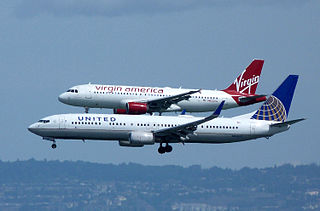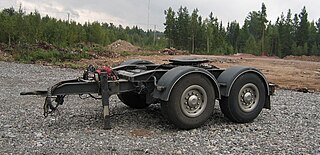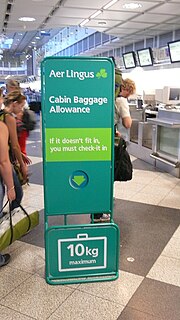
An airliner is a type of aircraft for transporting passengers and air cargo. Such aircraft are most often operated by airlines. Although the definition of an airliner can vary from country to country, an airliner is typically defined as an airplane intended for carrying multiple passengers or cargo in commercial service. The largest of them are wide-body jets which are also called twin-aisle because they generally have two separate aisles running from the front to the back of the passenger cabin. These are usually used for long-haul flights between airline hubs and major cities. A smaller, more common class of airliners is the narrow-body or single-aisle. These are generally used for short to medium-distance flights with fewer passengers than their wide-body counterparts.

Checked baggage is luggage delivered to an airline or train for transportation in the hold of an aircraft or baggage car of a passenger train. Checked baggage is inaccessible to the passenger during the flight or ride, as opposed to carry-on baggage.

Lost luggage is luggage conveyed by a public carrier such as an airline, seafaring cruise ship, shipping company, or railway which fails to arrive at the correct destination with the passenger. In the United States, an average of 1 in 150 people have their checked baggage misdirected or left behind each year.

In airport terminals, a baggage reclaim area is an area where arriving passengers claim checked-in baggage after disembarking from an airline flight. The alternative term baggage claim is used at airports in the US and some other airports internationally. Similar systems are also used at train stations served by companies that offer checked bags, such as Amtrak in the United States.

Baggage or luggage consists of bags, cases, and containers which hold a traveler's personal articles while the traveler is in transit. A modern traveler can be expected to have packages containing clothing, toiletries, small possessions, trip necessities. On the return trip, travelers may have souvenirs and gifts. For some people, luggage and the style thereof is representative of the owner's wealth and status. Luggage is constructed to protect the items during travel, either with a hard shell or a durable soft material. Luggage often has internal subdivisions or sections to aid in securing items. Handles are typically provided to facilitate carrying, and some luggage may have wheels and/or telescoping handles or leashes to make moving them easier.

In aviation, aircraft ground handling defines the servicing of an aircraft while it is on the ground and (usually) parked at a terminal gate of an airport.

The term hand luggage or cabin baggage refers to the type of luggage that passengers are allowed to carry along in the passenger compartment of a vehicle instead of a separate cargo compartment. Passengers are allowed to carry a limited number of smaller bags with them in the vehicle, which typically contain valuables and items needed during the journey. There is normally storage space provided for hand luggage, either under seating, or in overhead lockers. Trains usually have luggage racks above the seats and may also have luggage space between the backs of seats facing opposite directions, or in extra luggage racks, for example, at the ends of the carriage near the doors.

Bag tags, also known as baggage tags, baggage checks or luggage tickets, have traditionally been used by bus, train, and airline carriers to route checked luggage to its final destination. The passenger stub is typically handed to the passenger or attached to the ticket envelope:
- to aid the passenger in identifying their bag among similar bags at the destination baggage carousel;
- as proof—still requested at a few airports—that the passenger is not removing someone else's bag from the baggage reclaim hall; and
- as a means for the passenger and carrier to identify and trace a specific bag that has gone astray and was not delivered at the destination. The carriers' liability is restricted to published tariffs and international agreements.

A baggage carousel is a device, generally at an airport, that delivers checked luggage to the passengers at the baggage reclaim area at their final destination. Not all airports use these devices. Airports without carousels generally deliver baggage by placing it on the floor or sliding it through an opening in a wall.

A dolly is an unpowered vehicle designed for connection to a tractor unit, truck or prime mover vehicle with strong traction power.
IATA delay codes were created to standardise the reporting by airlines of commercial flight departure delays. Previously, every airline had its own system, which made the sharing and aggregation of flight delay information difficult. IATA standardised the flight delay reporting format by using codes that attribute cause and responsibility for the delay; this supports aviation administration and logistics and helps to define any penalties arising. These codes are used in movement messages sent electronically by SITA from the departure airport to the destination airport and also in the internal administration of the airlines, airports and ground handling agents.

A baggage handling system (BHS) is a type of conveyor system installed in airports that transports checked luggage from ticket counters to areas where the bags can be loaded onto airplanes. A BHS also transports checked baggage coming from airplanes to baggage claims or to an area where the bag can be loaded onto another airplane.

Aviapartner, whose origins date back to 1949 under the name of Herfurth Air Services to become 'Belgavia' in the late 1960s, is a Belgian company that provides ground handling services at 37 airports in Belgium, France, Germany, Italy, Spain and The Netherlands. Among the airports served are Amsterdam, Brussels, Milan, Düsseldorf, Rome, Nice, Toulouse and Málaga.

Ground support equipment (GSE) is the support equipment found at an airport, usually on the apron, the servicing area by the terminal. This equipment is used to service the aircraft between flights. As the name suggests, ground support equipment is there to support the operations of aircraft whilst on the ground. The role of this equipment generally involves ground power operations, aircraft mobility, and cargo/passenger loading operations.

Baggage carts, luggage carts, luggage trolleys or trolleys are small vehicles pushed by travelers (human-powered) to carry individual luggage, mostly suitcases. There are two major sizes: One for big luggage and one for small luggage. Carts have usually two parts for carrying luggage: A small section (basket) for carry on luggage at the same level as the handle, and a lowered large section for suitcases a small and large bags.

Airport check-in is the process whereby an airline approves airplane passengers to board an airplane for a flight. Airlines typically use service counters found at airports for this process, and the check-in is normally handled by an airline itself or a handling agent working on behalf of an airline. Passengers usually hand over any baggage that they do not wish or are not allowed to carry in the aircraft's cabin and receive a boarding pass before they can proceed to board their aircraft.

On the commercial transportation, mostly with airlines, the baggage allowance is the amount of checked baggage or hand/carry-on luggage the company will allow per passenger. There may be limits on the amount that is allowed free of charge, and hard limits on the amount that is allowed.

An aircraft lavatory or plane toilet is a small room on an aircraft with a toilet and sink. They are commonplace on passenger flights except some short-haul flights. Aircraft toilets were historically chemical toilets, but many now use a vacuum flush system instead.
Gate check bags are travel bags specially designed for the transportation and storage of car seats and strollers or pushchairs. Generally used for airline travel, they also provide protection from dust when in storage for the occasional user. When used for airline travel the strollers and car seats are placed in gate check bags at the departure gate before boarding. The bags protect strollers and car seats from dirt whilst in the loading or cargo bay as well as from elements such as rain or snow if left on the tarmac.

A baggage sizer, also known as a bag sizer, is a piece of furniture that is used primarily at airport check-in desks and boarding gates to assist and inform passengers and airport ground staff of baggage size limits for personal and cabin luggage or bags.




















